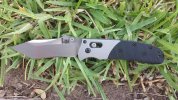Thanks for adding the personal opinion disclaimer. Unfortunately, you are mistaken on a few key opinions. A tanto is not harder to sharpen, does not lose its edge quicker than a spearpoint or whatever blade, does not require more upkeep, and certainly do not have a shorter service life. That is pure uninformed opinion and sounds like hearsay.
I've not found in many years of owning and using various tanto blades that it is either limited or worse at any task than a comparably designed knife with similar steel and specs. Is the tanto an ideal tool for skinning? Of course it isn't. If it were you'd see the resemblance in knives marketed and sold as skinners. A spear point can have many different grinds, as can a tanto. It can include a hollow grind, convex grind, saber grind, flat, or full flat grind. Blade shape doesn't dictate grind in all cases, nor does it dictate usage. A knife is simply an object, until it gets into the hands of a person with some skill for the task at hand then it becomes a tool.

I love how my
opinion is wrong by default because it contrasts your own opinion. Should I elaborate on why I feel as I do, or will that also be by invalid by default?

First off, I try not to speak from hearsay. And when I am speaking something that is my opinion, I note it rather than conveying something as fact. And I believe here I did a good job in conveying my post was my personal opinion rather than actual fact. I am one person. I have my experience. One's person experience is just that.
Where is my opinion from? This is from my personal experience of owning two Benchmade AutoStryker models and various other models I have owned with western (more or less, modifications from Lum's), but mainly from the BMs because I had the same knife to compare. The models were the 9100SBK (154CM, tanto) and 9130SBK (154CM, spear point). Both were first generation AutoStryker models from when BM listed their 154CM as 58-60 HRC, and at the time were being sharpened on a SharpMaker. I also had at one point a standard drop point Mini Grip and a tanto Mini Grip although I did not use them side-by-side in the fashion I did the AutoStrykers (LIMIT-obviously my ability to sharpen plays into affect, although I felt I could get both reasonably sharp.)
As for sharpening, you have stated in the past that you feel having the two mainly straight angles makes it one of the easiest to sharpen. I feel it is more involved with upkeep and find it more difficult for this exact reason (and I think you will find there are people on both sides of the argument as to easy v. difficult). I assume you probably use the method Emerson advises which is sharpening each plane as if you were sharpening two smaller knives which is what I have used. To me, that is more difficult to do and more upkeep than a standard drop point that I can take a few quick passes at and be done. Maybe most tantos are super easy to upkeep to you, but to me they are almost never as easy as a drop point counter.
http://emersonknives.com/blog/sharpening-your-emerson/ (LIMIT-having sharpened many more drop points than tantos, chances are my speed in sharpening is not as fast as someone with extensive experience who has sharpened tantos hundred and hundreds of times and I would rate my sharpening skills at an intermediate level.)
As for wear, I found that progressive wear from usage/sharpening will begin to round out the corner between the two planes and the blade slowly becomes more of a deformed drop point over time as that corner starts to round.
(at an earlier stage
http://www.poteau-oil.com/photography/firearm2012/benchmade9100-07.jpg)
One of the reasons I really like the drop point is because most of mine have worn evenly over time and I also find that drop points are super easy to reprofile tips on and make the blade look and function as it did prior to the broken tip (useful for a knife being used for utility). (NOTE-I chipped the area on my 9100 very close to the corner. Upon sharpening through the chip, the additional metal removal resulted in accelerated wear [above is a linked picture to another knife].)
And you are right that there is much variation. I should have said I was speaking specifically to the Benchmade tantos I have owned. Now if we take something like the Emerson CQC-15, that's a whole different story as Emerson has really made the design more useful by hybridizing the blade, giving it tremendous strength, piercing power, and utility capability. I think that certain Kissaki grinds are much more desirable than what we see today on most production folders. If we take something like the XM-18's Spanto, I see a blade with many design similarities to the Chu which is a friggin awesome performer for virtually all tasks.
But the standard Western tanto we see commonly on BMs and other production knives to me is ultimately a combat grind made for penetrating objects that are hard to penetrate. To my understanding, it's primary purpose is to penetrate light armor by quickly widening the hole sufficiently for full insertion when the physical momentum/force is at its greatest to defeat the barrier (versus most other grinds in which the widest point of the knife would not penetrate until substantially later in the process when the force generated is less than it would be with the tanto that reaches its widest point much sooner). Utilitarian value takes a back seat. You may find it to perform as well as other grinds, but I do not.
Some people really like tantos. Some don't. I fall into the latter.










